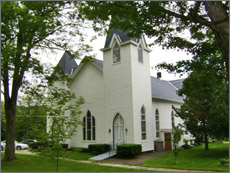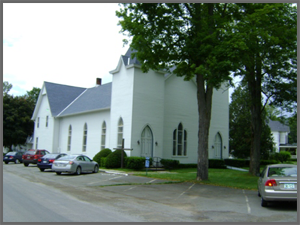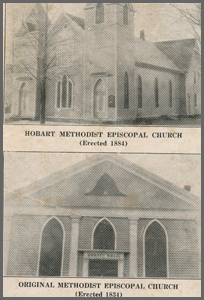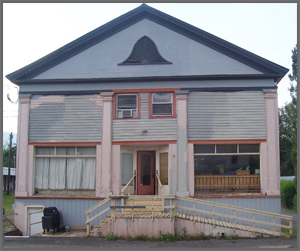| Back to Historical Articles |
HOBART & TOWNSHIP - UNITED METHODIST
 No history of any Methodist Church is complete without reference to the vital beginnings of Methodism. Early one evening in May, 1738, John Wesley met with as small group in a little room on Aldersgate Street in London. There, as he listened to the leader read Luther’s preface to the Epistle to the Romans, he felt his heart “strangely warmed,” and received the assurance of salvation by faith alone. As a result of this heart-warming experience, he was to begin a religious revival that was to change the history of religion in England and result in the founding of the Methodist Church.
No history of any Methodist Church is complete without reference to the vital beginnings of Methodism. Early one evening in May, 1738, John Wesley met with as small group in a little room on Aldersgate Street in London. There, as he listened to the leader read Luther’s preface to the Epistle to the Romans, he felt his heart “strangely warmed,” and received the assurance of salvation by faith alone. As a result of this heart-warming experience, he was to begin a religious revival that was to change the history of religion in England and result in the founding of the Methodist Church.
Shortly afterward, the movement spread to America and the first society was organized in 1766. Wesley ordained Thomas Coke as Methodism’s first Bishop, at that time referred to as General Superintendent, and sent him in turn to ordain Francis Asbury. The two were officially elected at the Christmas Conference on December 24, 1784, at Lovely Lane Chapel, Baltimore. At that time there were 84 preachers and some fifteen thousand members. By the time of the church’s 200th anniversary, there were more than 10 million members.
METHODISM IN HOBART
History records that when John Olmstead moved to Township from Connecticut in 1794, he found a Methodist Society already in existence. As an outgrowth of a revival movement, the Township Church was built in 1823, and still serves the people of the Township Valley.
In 1834, at a meeting in the home of John Allen, the Hobart Methodist Society was organized. This became the second society for the residents of Stamford, Kortright, and Harpersfield. The church was built on the present site that year, and dedicated with a Sabbath School in 1835. The Rev. Bezeleel Howe of the Kortright Circuit was its first pastor. Hobart and Township have shared their pastor, except for a short period around 1857.
In 1854 the church was renovated and improved at a cost of $1,000. In 1867, under the leadership of the Rev. F. G. Gale, a great revival took place, which added many new converts, some in middle age. These were years of rapid growth, both for the church and for the community. Thus, at the death of Levi Olmstead, the son of John, his widow, Rhoda Silliman Olmstead offered $3,000 toward the erection of a newer and larger church. The present church was built early in 1885 at a cost of $7,000 and dedicated free of debt in October of that year. The beautiful stained glass window between the front entrances is a fitting memorial to Levi Olmstead. The bell, still in use, was given in memory of Jacob Van Valkenburg by his widow, Eunice P. Van Valkenburg Hanford.
The old church was purchased by Hume Grant, moved to its present location on Cornell Avenue, and was used as a Town Hall, with a grocery store beneath. It later served as the hardware store of E. T. Van Buren and Sons. In 1903 the parsonage was moved to its present site on Pearl St., where it served as the remodeled residence of Mr. and Mrs. George Stevens. A new parsonage was built on the old site at a cost of $5,000, with all but $1000 given by John Olmsted, son of Levi.
Between the years of 1907 and 1908 the church received nearly $17,000 from the estate of John M. Olmstead and his wife Sarah. This began a trend in the church which continues to this day.
 An Estey pipe organ and electric lights were installed in 1913. Also at that time, an altar painting was presented by the Rev. Paul St. John Coleman, artist and pastor of the church at the time. Lest we think that the Hobart church thought only of itself, let it be noted that in 1921 this church gave more for missions that it spent for the pastor’s salary. It has always maintained a reputation for paying all apportionments and even going the second mile.
An Estey pipe organ and electric lights were installed in 1913. Also at that time, an altar painting was presented by the Rev. Paul St. John Coleman, artist and pastor of the church at the time. Lest we think that the Hobart church thought only of itself, let it be noted that in 1921 this church gave more for missions that it spent for the pastor’s salary. It has always maintained a reputation for paying all apportionments and even going the second mile.
The year 1925 brought many changes under the leadership of the Rev. Luther K. Hannum. New carpeting, pews – still in use but presently refinished – new light fixtures, a choir panel in Gothic style – later replaced – a stained glass window in memory of Sarah and John Olmstead, and one given by Charles and A. L. O’Connor in memory of their mother, Annie T. O’Connor, brought new beauty to the sanctuary.
In 1934, while shepherded by the Rev. Samuel A. MacCormac, the church celebrated its first centennial with many services, including one conducted by Bishop MacConnell. At that time the O’Connor family presented the church with 100 new hymnals. These years saw many new members added and new equipment and furniture installed. Repairs were made in the parsonage, as well. The pastoral salary at that time was $2,500.
The District Superintendent’s report of 1939 recorded, with sorrow, the death of Helen Gould Shepherd. The Rev. W. H. Quinn served the charge until his death in Hobart in 1944, and he was buried in Locust Hill Cemetery. A truly great Christian, Mr. Quinn interested the youngpeople, and added 52 new members.
In 1934 the church received $918.61 from the estate of Mrs. Diantha Close. In 1943 E. T. Van Buren started a memorial fund with a gift of $1,000. The Anna Silliman estate provided a legacy of $1,000
in 1944. The O’Connor family began a memorial fund, and $75,000 was later received from Charles O’Connor’s estate.
The parsonage was enlivened by the arrival, in 1944, of the Kenneth. E. Hoover family. With five children, they began a trend which continued for many years. Pastor Hoover brought the charge good fellowship, sermons to reawaken the gospel message, cottage prayer meetings, and Sunday vespers. The church began newsletters to servicemen and a demobilization committee with William Van Buren in charge.
A heifer for European relief was purchased by the Anna Carroll Circle in 1946 at a cost of $125, and altar ware was given by Marshall K. Mayes in the same year. The Van Buren family landscaped the front of the church in memory of their mother. The fire escape from what was then an upstairs kitchen was installed in 1947.
Kenneth Truran brought his family to the charge in 1949 and deepened the life of the church. Several new projects, the ministerial pension fund, the Advance for Christ program, a Spiritual Life Mission, and a United Evangelistic Mission, were introduced. Missionaries Isabelle Kennedy of Hawaii and Richard Moore of India came to speak.
After much consideration of the needs of the church school and social activities of the church, the decision was made to excavate a basement. George Flower headed a building committee which began the work that has resulted in the basement kitchen and Fellowship Hall. The lovely Fireplace Room was completed, furnished and given by George Flower in memory of his wife, Angie. The old kitchen and upstairs rooms were remodeled to become the Junior Department of the church school. The lower floor was brought to its present condition for the Primary Department. A new heating plant and basement rest rooms were also installed.
Pledges from the congregation, the growing revenue from the trust fund, and a loan of $15,000 made these projects possible, along withgenerous amounts of volunteer labor.
In 1949, F. M. Lyon started a chime fund, and later his sons and the trustees added to it. The E. T. Van Buren estate provided $2,000 in 1952. In 1954 the chimes were installed. In 1957 extensive renovations were begun on the parsonage and were added to from time to time. In 1958 a policy was instituted by the trustees for the division of the excess income from the trust fund which made possible large benevolence budgets and several additional projects.
The Peace Hanford estate provided funds for the completion of the basement project in 1960.
In addition to these specific projects, these gifts, particularly that of the O’Connor family, have made possible a large endowment fund.
In 1973 the Hobart church confounded UMCOR officials by donating more than $17,000 to that cause, more than any other church in the world had ever given in one year in UMCOR’s 30-year history. They questioned that a “small rural church” could possibly achieve this feat, and asked to come to thank the congregation in person. The generosity was, of course, thanks to the church’s trust fund and investments.
The highlight of 1974 was the celebration of the 150th anniversary of the Township Church, which included a performance by a “Circuit Rider” and drew an overflow congregation, with about 75 watching on closed circuit TV outside.
In 1976 a much-needed new roof was installed on the Township Church, and the Hobart church received steel siding. The Hobart youth choir,“Joy Unlimited,” made a seven-state musical tour to share their faith, talent and commitment.
In 1985 United Methodism celebrated its bicentennial, and the Bangs family of Township was among those especially honored. Pastor Hobbs increased his, and the church’s, understanding of mission needs in Africa when he journeyed to Mozambique.
In 1990, the Township trustees examined the building and found extensive repairs which needed to be made. The Hobart church began a project to install a handicapped lift, to facilitate access to all four levels of the church, and work was completed the following year. A van ministry also helped provide access to church services and other events. At the same time, the Township church underwent major repairs to put the building on “a firm foundation.”
Use of the Wesley House also changed during 1991. It had been used as church office and an apartment for the choir director. After Ed Harbaugh moved out, and Pastor Elder moved his office to the parsonage basement, the building was used by the Delaware Co. Red Cross as its headquarters. This lasted until 2002, when the Red Cross moved to Delhi, and Project Independence rented the building for office space.
 In 1993 both congregations joined for a service led by Bishop Stith to celebrate 170 years of ministry from the Township church (and 199 years year of Methodist ministry in the Township valley).
In 1993 both congregations joined for a service led by Bishop Stith to celebrate 170 years of ministry from the Township church (and 199 years year of Methodist ministry in the Township valley).
Additional parking was made available in Hobart in 1997-98 with the purchase of a house across Pearl St. The building was torn down, the siding used on the drafty Wesley House, and the fixtures sold. One of its beams was used to erect a large cross at the church entrance. The garage was used to house large equipment. The church kitchen was renovated to provide a commercial-type range and ovens to help with the many dinners, including the annual Harvest Dinner which funded the Crisis fund (used for the needy in the local community). A series of “sub” sales also helped with funding.
A catastrophic ice storm in northern NY in 1998 brought a quick response from both churches, with not only donations of money, but also with practical assistance from a group from the congregation who journeyed to the area to provide manual help, and deliver needed materials and food.
PASTORS OF THE CHARGE
The following were pastors of the Hobart-Township charge:
1834-1835 Bezeleel Howe
1835-1837 D. Stark
1837-1839 R. H. Bloomer
1839-1840 James Floy
1840-1842 William Lull
1842-1844 David Turner
1844-1845 Addie Lee
1845-1847 R. S. Scott
1847-1849 Hiram Lamont
1949-1851 Jason Wells
1851-1853 William Smith
1853-1855 William Mitchell
1855-1857 Ira Ferris
1857-1858 Aaron Rodgers
1858-1860 William Goth
1860-1862 Robert Kerr
1862-1864 Sanford Ferguson
1864-1866 W. F. Harris
1866-1868 A. G. Gale
1868-1869 William D. Fero
1869-1870 Ezra Tucker
1870-1873 I. R. Van Dewater
1873-1876 Charles B. Landen
1876-1879 Charles C. Millar
1879-1880 Lyman W. Wadsworth
1880-1883 Orvin P. Dales
1883-1886 Sheldon Merchant
1886-1890 A. M. Gay
1890-1893 A. E. Lord
1893-1895 John W. Bohlman
1895-1899 Augustine Walker
1899-1901 William C. Oliver
1901-1905 George O. Welsey
1905-1909 Frank D. Abram
1909-1912 Alpheus M. Morgan
1912-1917 Paul St. John Coleman
1917-1921 Alfred M. Wilkins
1921-1923 Robert J. Harrison
1923-1929 Luther K. Hannum
1929-1930 James V. Taylor
1930-1936 Samuel A. MacCormac
1936-1939 Herbert Killinder
1939-1943 W. H. Quinn
1943-1949 Kenneth E. Hoover
1949-1960 Kenneth Truran
1960-1978 J. Philip Gehres
1979-1984 Howard Newton
1984-1986 Henry Hobbs
1986-1990 David Young
1990-2004 Richard Elder
2004-present Lorraine Coscia-Ackerman
RESPONSE -
Betty Van Buren Bergleitner
February 24, 2011 at 1:19 am | Permalink | Reply
I have a few photos of the Cornell Avenue church when it was our family business run as E.T.VanBuren and Sons. I worked with/fpr my Dad in his business from the time I was a young gal….in several capacities (Saturday a.m. “duster” of our hardware department, head of our toy store, bookkeeper, “printer” of the VB News and sales clerk).
